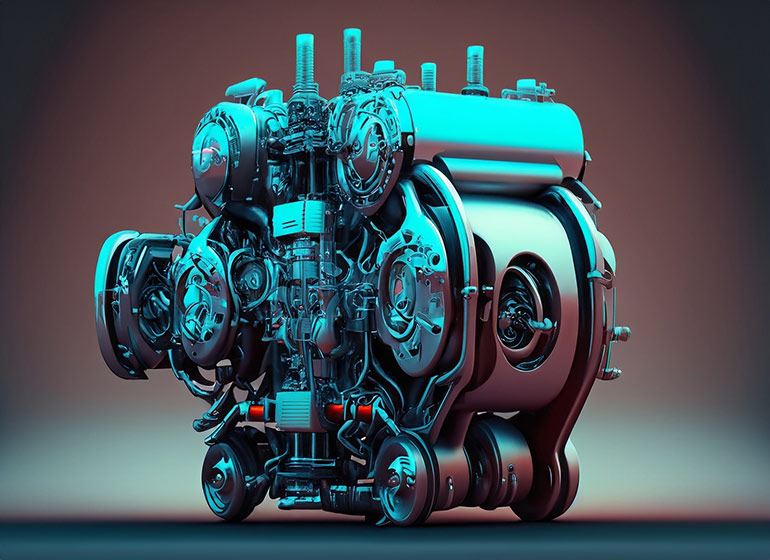If you’re a longtime reader, you know I like to stay positive, keep it topical and look to the future. I try to stay up on fluid power trends. With trends, we often have to endure excruciatingly boring pitches from factory sales professionals acting like their new blah blah blah system will revolutionize the breather cap.
I get it if you’re a niche manufacturer making explosion-proof needle valves for the underwater hydraulic sewing machine industry. You do you, king. But everyone else is promising the newest, greenest technology in their hydraulic pump systems, with special diamond-coated wear plates reducing friction by half a percent, and are now part of their “Rocket” program that guarantees delivery in only 537 weeks.

Here’s a futuristic hydraulic system, generated by AI.
Image courtesy of Adobe Stock
The trend of advanced hydraulic pump and control combinations touted to improve performance while reducing energy has been a mainstay of tradeshows and magazine ads for over a decade, but nobody’s buying them. Their expense is overshadowed by their investment and implementation costs that make them out of reach for anyone this side of a carbon-tax credit chaser all but a pipe dream.
And you can’t scroll nine seconds down your LinkedIn feed without bumping into braggarts and their world-changing bit data platforms. I know what data are, but I struggle to find them on the XXL rack at Winners. Oprah even had a special episode discussing the subject, “You get big data, you get big data, everybody gets big data.” Okay, so we all got data; now what?
Maybe I’m tainted by a lack of unification under any unified technology platform to take us to the fluid power promised land. It’s great that your Industry 4.0-ready power unit told you the filter will need changing in three weeks, but your maintenance planner’s Excel spreadsheet already did that. And their spreadsheet included the maintenance details for all 37 of your machines, not just the fancy new one hooked up to the internet.
The trend I have faith in (but am also kind of scared of) is AI. All the above advancements come together when artificial intelligence is applied to data, IoT and smart machines. Imagine your smart power unit telling you to check your oil because it noticed a rapid increase in filter differential pressure over the past three days that didn’t jibe with the previous three filters used on the machine.
Machine learning, optimization and forecasting happen automatically or at least provide operators and maintenance personnel with recommendations for improving performance. Imagine your automation cell optimizing itself as it learns which pressure and flow characteristics provide the highest productivity, fewest rejects and reduces energy usage along the way. Did I say it can do all this automatically?
Mind you, AI is not a fluid power-specific trend. In fact, not much of the advancement in fluid power in the past few decades applied to anything outside of electronics. Sure, manufacturing materials and techniques have improved, and sealing technology has allowed pumps and actuators to perform in previously impossible ways.
We’ve also combined traditionally separate components into self-contained electro-hydraulic hybrid actuators where you get the force capability of a two-inch bore hydraulic cylinder in a package the size of a twelve-inch bore cylinder. It’s like looking at the scene in Austin Powers, Goldmember where Austin stands on Mini-Me’s shoulders to prepare for their medical exam. The motor, pump, reservoir and valves all sit atop the cylinder. It’s a great idea, I suppose, since wimpy electrics need high-pressure oil to do anything useful. Yeah, I went there – come at me, bro.
I hope something comes along in fluid power that blows my mind with its game-changing technology, like superfluid or nano-something-or-other. We need something so clearly game-changing that it rises above trendy solutions to old problems. We need to do more than simply evolve by piggybacking electronic technology. But until that day, I’ll sit back and watch fluid power trends ebb and flow while occasionally making fun of them.
Filed Under: IoT, Trending